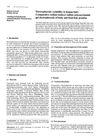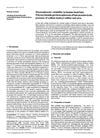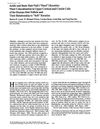TLDR Family members have similar hair protein patterns, which could be useful for genetic studies.
The study conducted electrophoretic analysis of non S-carboxymethylated human keratins extracted from the hair of individuals from 3 Italian families. Using SDS-PAGE and isoelectric focusing (IEF), hair fibrous proteins (HFP) were separated into polypeptide bands with molecular weights of 52 KDa, 44 KDa, and 40 KDa, and isoelectric points ranging from pH 7.4 to 4.0. Hair matrix proteins (HMP) were separated by IEF into bands with isoelectric points from pH 7.4 to 5.4, but could not be characterized by SDS-PAGE due to low concentration. Total extracted hair keratins showed additional bands at 16 KDa and 12 KDa. No interindividual variability was observed in electrophoretic patterns, except for one woman possibly affected by cosmetic treatment. Family members exhibited more similar patterns than unrelated individuals, suggesting that electrophoretic analysis of hair keratins could aid in genetic studies.
90 citations
,
July 1993 in “Journal of Investigative Dermatology” 10 citations
,
January 1989 in “Archives of Dermatological Research” The study conducted a two-dimensional electrophoretic analysis of human hair keratins, focusing on hair matrix proteins (HMP) and hair fibrous proteins (HFP). The proteins were converted to S-carbamoylmethylated derivatives to facilitate separation by isoelectric point and molecular weight. The analysis revealed that SCam-HFP consisted of polypeptides with molecular weights of 41.5–59 kD and isoelectric points (IP) of pH 5.1-6.8. SCam-HMP were divided into acidic and basic groups, with the acidic HMP showing variation among hair samples from 15 individuals in four Japanese families. This method was deemed suitable for biochemical analysis of human hair keratins, particularly nonfilamentous HMP.
 11 citations
,
January 1987 in “Electrophoresis”
11 citations
,
January 1987 in “Electrophoresis” Keratin proteins are consistent across different hair types from the same person.
 15 citations
,
January 1987 in “Electrophoresis”
15 citations
,
January 1987 in “Electrophoresis” Human head hair proteins can be typed into eight distinct patterns, useful for genetic and forensic investigations.
 356 citations
,
December 1986 in “The journal of cell biology/The Journal of cell biology”
356 citations
,
December 1986 in “The journal of cell biology/The Journal of cell biology” Hair and nail cells share similar proteins, indicating a common differentiation pathway.
198 citations
,
October 1986 in “Differentiation”


